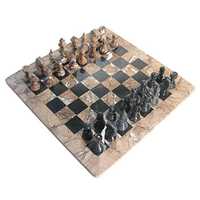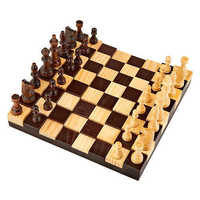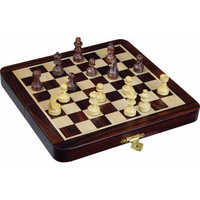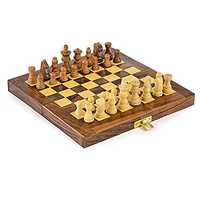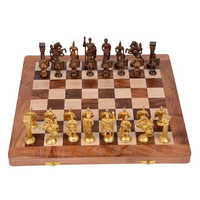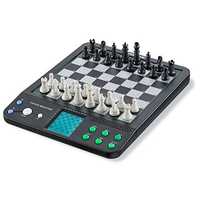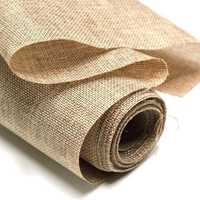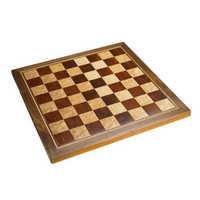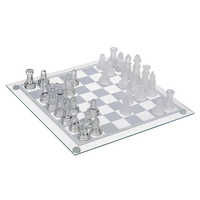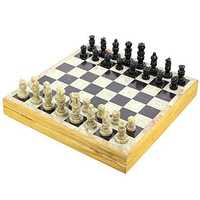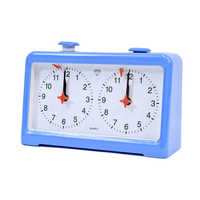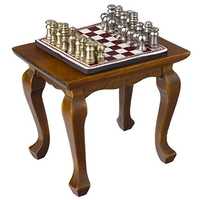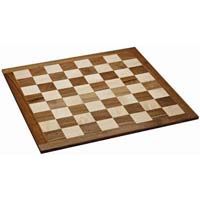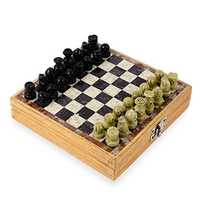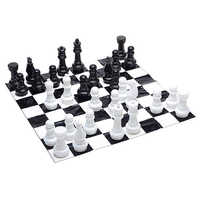Chess Board
(480 products)
Explore More Categories
Made in India
Square Brown Bar Set Wooden Chess
Price: 530.00 INR (Approx.)/Set
MOQ - 5 Set/Sets
Color - Brown
Type - Chess Box
Material - Wooden
13 Years
Business Type: Manufacturer | Distributor
GIFTMART
Made in India
Fancy Wooden Chess Age Group: Above 8 Year Old
Price: 6500 INR (Approx.)/Unit
MOQ - 10 Unit/Units
Age Group - Above 8 Year Old
Toys Type - Chess
Toys Material - Wood
16 Years
Business Type: Manufacturer | Exporter
SUNIDHI INTERNATIONAL (INDIA)
Made in India
Metal Players Durable Chess Board Age Group: All
Price Trend: 1-30 USD ($) (Approx.)/Piece
MOQ - 100 Piece/Pieces
Type - Chessboard
Material - Wooden
Color - Black
3 Years
Business Type: Manufacturer | Exporter
ALSA INTERNATIONAL
Made in India
10 Inch Wooden Chess Board Age Group: All
MOQ - 20 Piece/Pieces
Type - Chessboard
Material - Wooden
Color - Brown
2 Years
Business Type: Manufacturer
GOGALGAI TOYS
Stone Chess Board Set Age Group: All
Price: 8.40 USD ($) (Approx.)/Set
MOQ - 50 Set/Sets
Type - Chess Box
Material - Stone
Color - Brown
4 Years
Business Type: Manufacturer | Supplier
LEELA HANDICRAFT
Verified Exporter
( Accepts only Foreign Inquiry)
Made in India
Wooden Chess Board Age Group: All
Price: 1800 INR (Approx.)/Unit
MOQ - 1 Unit/Units
Type - Chessboard
Material - Wooden
Color - Brown, White
1 Years
Business Type: Manufacturer | Distributor
Rambo Fitness Equipment
Natural Square Chess With Drawer
Price Trend: 9170.00 - 10945.00 INR (Approx.)/Piece
MOQ - 1 Piece/Pieces
Type - Chessboard
Material - Wooden
Color - Natural
10 Years
Business Type: Manufacturer | Distributor
G & A INTERNATIONAL
Made in India
Chess Set
5 Years
Business Type: Manufacturer | Exporter
RITVEYRAAJ CARGO SHIPPING CONTAINERS
Indian Inquiries Only
Foldable 18x18 Inch Square Wooden Chess Set With Magnetic Features
Price: 650 INR (Approx.)/Piece
MOQ - 100 Piece/Pieces
Type - Chessboard
Material - Wooden
Color - Brown
2 Years
Business Type: Manufacturer
Balaji Enterprises
14X14 Inch Wooden Chess Board Age Group: All
Price: 100 INR (Approx.)/Piece
MOQ - 10 Piece/Pieces
Type - Chessboard
Material - Wooden
Color - Wood
6 Years
Business Type: Manufacturer
RAMAN BIHARI INDUSTRIES
21 Inch Roman Brass Chess Set - 21 Inch Chess Board Age Group: All
Price: 4000 INR (Approx.)/Piece
MOQ - 5 Piece/Pieces
Color - Multicolor
Type - Chessboard
Material - Other
3 Years
Business Type: Manufacturer | Exporter
PARAMOUNT DEALZ
Verified Exporter
( Accepts only Foreign Inquiry)
Chess Board Age Group: All
Price: 280 INR (Approx.)/Piece
MOQ - 100 Piece/Pieces
Type - Chessboard
Material - Plastic
Color - Black n White
2 Years
Business Type: Manufacturer | Distributor
Roshan Traders
Folding Chess Board
Price: 2199 INR (Approx.)/Set
MOQ - 1 Set/Sets
7 Years
Response Rate: 89.36%
Business Type: Distributor | Exporter
KD SPORTS & FITNESS
Indian Inquiries Only
Made in India
White And Black Handmade Italian Marble Chess Coins Set With High Class Velvet Box Cover
Price: 1500 INR (Approx.)/Set
MOQ - 50 Set/Sets
Color - White And Black
Type - Chess Box
Material - Stone
1 Years
Response Rate: 75%
Business Type: Manufacturer | Supplier
Vaishnavi Handicrafts Gateway
Premium Quality Portable Wooden Chess Board Set For Professional Chess Players Age Group: All
Price: 250 INR (Approx.)/Pair
MOQ - 100 Pair/Pairs
Type - Chessboard
Material - Wooden
Color - Natural Wood
Business Type: Manufacturer | Distributor
MANGLAM TRADERS
Set of 4 Marble and Acacia Coasters for Drinks
Price: 400 INR (Approx.)/Set
MOQ - 50 Set/Sets
Style - Customized
Weight - 3 Kilograms (kg)
Age Group - All
Business Type: Manufacturer | Supplier
Stone Craft
Wooden 12 Inch Stone And Wood Chess Board
Price: 850 INR (Approx.)/Unit
MOQ - 100 Unit/Units
Type - Chessboard
Material - Wooden
Style - Antique
Business Type: Manufacturer | Supplier
ADSUP MARKETING SOLUTIONS LLP
Premium Design Teak Wood Wooden Chess Board
Price: 900 INR (Approx.)/Piece
MOQ - 100 Piece/Pieces
Type - Chess Box
Material - Wooden
Color - Brown
Business Type: Manufacturer | Supplier
Royale Kings
Wooden Inlaid Chess Box Natural with Coins Folding
Business Type: Supplier | Trading Company
Ganga Ram Tulsi Ram
Resin Chess Boards
Business Type: Manufacturer
J. P. Craft India
Customized Brass Chess Sets
Color - Customized
Business Type: Supplier | Trading Company
A. V. Handicrafts
Brown Arux Magnetic 10 Inches Foldable Wooden Chess
Price: 1345 INR (Approx.)/Number
MOQ - 1 Number
Type - Chess Box
Material - Wooden
Color - Brown
Business Type: Trading Company
ROLLOVERSTOCK
Light Weighted Square Shape Polished Finish Corrosion Resistant Silver Chess Boards
Price: 2700 INR (Approx.)/Piece
Type - Chessboard
Material - Other, Silver
Color - as Shown in The Image
Business Type: Manufacturer
SHUBHAM SILVER
Hand Painted Wooden Chess Set Age Group: Adults
Price: 2800 INR (Approx.)/Unit
MOQ - 1 Unit/Units
Color - Brown
Type - Chess Box
Material - Wooden
Business Type: Manufacturer | Supplier
AXUSS CORPORATION
Wooden Chess Board
Price Trend: 30-5000 INR (Approx.)/Piece
MOQ - 1 Piece/Pieces
Business Type: Manufacturer | Supplier
M/S MINI SPORTS
Beautiful and Elegant Handmade Marble Black Zebra and Fossil Chess
Price Trend: 25.00 - 40.00 USD ($) (Approx.)/Piece
MOQ - 100 Piece/Pieces
Type - Chessboard
Material - Other, Marble
Age Group - Adults
Response Rate: 100.00%
Business Type: Manufacturer | Distributor
Nida Trading
Black Wooden Carving Chess Set
Price: 5500 INR (Approx.)/Set
MOQ - Any Order Set/Sets
Color - Black, White
Type - Other, Chess Set
Material - Wooden
Business Type: Manufacturer | Distributor
AADITYA EXPORTS
METAL CHESS SETS
Business Type: Manufacturer | Supplier
JOSHUA INDUSTRIES
Chess Board Manufacturers | Suppliers in India
| Company Name | Location | Member Since |
|---|---|---|
| Sunidhi International (India) | Delhi, India | 16 Years |
| Giftmart | Mumbai, India | 13 Years |
| G & A International | Meerut, India | 10 Years |
| Kd Sports & Fitness | Mumbai, India | 7 Years |
| Raman Bihari Industries | Hindaun, India | 6 Years |
| Ritveyraaj Cargo Shipping Containers | Mumbai, India | 5 Years |
| Leela Handicraft | Varanasi, India | 4 Years |
| Alsa International | New Delhi, India | 3 Years |
| Paramount Dealz | Surat, India | 3 Years |
| Gogalgai Toys | Thane, India | 2 Years |
Chess Board Setup Explained
Chess is played on a board known as a chessboard. The chess pieces are arranged on its 64 squares, which are 8 rows by 8 columns, in rows and columns. It has a square form and is checked with squares in two different colours, one bright and one dark. The board is set up during play to ensure that both playersa right edge tile is a light square. On a chessboard, the rows and columns are known as ranks and the diagonals, which connect adjacent squares of the same colour on opposite sides of the board, are known as files. Chess notation may be either algebraic, descriptive, or numerical; algebraic notation is the FIDE standard. Each square on the board is given a name.
Every square is designated by the file and rank that it occupies in algebraic notation, which uses White's viewpoint. Files are named a through h from left to right, while ranks are labelled 1 through 8 from bottom to top. The kingside is made up of the e- through h-files, whereas the queenside is made up of the a- through d-files.
History And Evolution of Chess Boards
The Ashtpada board is the oldest known precursor of the chessboard. From about the 6th century in India, it was used to play a variety of games, including chaturanga, a historical forerunner of chess. The board is split into eight columns by eight rows and has a single colour for each square. The castle-shaped marked squares are placed in the corners of each quadrant. Castles in Chaturanga have no purpose, in contrast to Ashtpada. With the introduction of chess to Europe in the 10th century, the chessboard developed its contemporary chequered design. This design was modelled on the 5-by-5 draughts board of the time. Since each diagonal was now marked by a continuous line of squares with the same colour as it, the 15th century saw the creation of the modern bishop and queen moves.
In the Libro de Los Juegos (1283), a depiction of the chessboard is given. Eight rows and columns are described as the perfect number, with the 10 by 10 and the 6 by 6 boards being too rapid and monotonous, respectively.
Some players started following the practice in the 13th century that the first square in the far-right hand column ought to be bright in colour; Pedro Damiano later approved of this standard. In a set of four games played in a virtual environment in 2003, former world champion Garry Kasparov competed against the computer-generated chess engine X3D Fritz while using special glasses.
The computer-generated board floated in the air in front of Kasparov. It was the first chess match between a man and a machine that took place entirely in a computer simulation.
How Chess Pieces Move on Chess Board
The beauty of chess is that it is simple to learn yet challenging to master. The simple rules and seemingly limitless possibilities of this timeless game have attracted players from all walks of life for ages. You'll discover how the pieces move in the first post of a series on how to play the royal game. The king, the most significant chess piece, will be our first move.
The King's Movements: The king, designated by a crown carrying a cross, is free to move one square in any direction. It may travel in any directiona horizontal, vertical, or diagonal. The only squares your king cannot go to are those that are already occupied by one of your other pieces or pawns. They cannot enter the same square as another, and this is true of all of your pieces and pawns. But they can "capture" the squares where your rival's pieces are located. Simply swap out the enemy piece with your own and take it off the board to capture it. Additionally, your king cannot be placed on a tile where one of your opponent's pieces or pawns may capture it. Although it's generally not a smart idea, you may opt to let any of your pieces or pawns be taken, but it's against the law to let your king be captured according to chess regulations.
The Queen's Movements: The queen, the king's devoted partner, comes next. The queen may move any number of squares in any direction, diagonally, horizontally, or vertically, unlike her slothful husband. She is now by far the most potent tool you have at your disposal. Keep in mind that no chess piece, even the queen, may split its motion. In other words, the queen cannot be moved two squares forward and then four squares to the left in the same round. Per turn, you can only travel in one direction.
The Rook's Movement: The rook is up next. The rook, which resembles a castle tower, is another strong piece. It has the capacity to zoom in and out of any number of squares on the board, both horizontally and vertically. One of the two pieces used in casting is the rook.
The Bishop's Movement: The bishop is a further component that has infinite square-moving potential. The bishop may go down and up the chess board's diagonals with the help of its tall hat, which is often decorated with a cross. But there is one peculiar thing about the bishop. It cannot migrate to squares of a different hue since it can only move in diagonal directions. In other words, if your bishop starts on a bright square, it will always remain there, and if it starts on a dark square, it will always remain there! As a result, in a game of chess, having two bishops who can collectively cover all the squares is a significant advantage.
The Knight's Movement: The knight is up next. The knight on the chessboard, which resembles a horse, is a peculiar character. It can move in a manner that no other chess piece, not even the queen, can, for starters. The knight travels in the form of an "L," either moving two spaces vertically and one space horizontally, or vice versa. The knight's unique ability to leap over other pieces is its second peculiar quality. The knight cannot be blockaded by its friends or the opponents' pieces and pawns, although every other pawn and piece can. The knight is free to move to any square as long as no other pieces or pawns are on it.
Pawns' Movement: Knowing how the pieces move now allows us to move on to the pawns. Despite having the most intricate regulations, these tiny fellows are really rather simple. Pawns can only advance one space unless it's their first move, in which case they may advance two squares. Another crucial aspect of the game is that the only piece of your army that can travel backwards is a pawn. Every time you shift a piece, you make a decision that cannot be changed later. Pawns may change forms as well. A pawn may be transformed into any piece other than the king after it has been moved all the way to the opposite side of the board. Yes, if you'd like, you can even have a second queen. Because of this, it may come as no surprise that a typical tactic is to move a pawn to the opposite side of the board while preventing your adversary from doing the same.
But perhaps the most peculiar aspect of pawns would be how they seize other pieces. In most cases, capturing an opponent's piece involves simply moving your own piece to the square where the opponent's piece is located and taking it over. The only direction in which pawns may move is diagonal. To summarise, pawns are limited to one forward movement (or two on the opening move) and may only take pieces diagonally. So what occurs when a pawn comes face to face with another pawn or piece? Nothing. They just butt heads, unable of moving forward. A pawn cannot be captured by a piece moving forward, although a piece can. As a result, when two pawns come into contact with one another, they lock up.
Types Of Chess Board
Some different types of a chess board that you can find are:
- Silicone Chess Boards.
- Full-Colour Vinyl Chess Boards.
- Vinyl Chess Boards.
- Custom Printed Chess Boards.
- Straight Up Chess Boards.
- Electronic Chess Computers.
- Luxury Wood Chess Boards.
- Wood Chess Boards.
FAQs: Chess Board
Q: Why is a chessboard 8A 8?
Ans: 36 squares might be too crowded and impossible for 32 pieces to move around the board entirely; 49 squares would still be too crowded; 64 squares is just correct and are the ideal 8-square configuration.
Q: Does each square on a chessboard have a name?
Ans: An alphanumeric name or coordinate is assigned to each square on a chessboard.
Q: What is the cost of chess boards?
Ans: Chess boards can come as cheap as rupees 100 if you are looking for plastic ones, and increase in price with better material and quality such as wood and metal.
Q: How many squares are there on a chessboard?
Ans: There are 64 squares on a chessboard.
Related Categories
Adventure Sporting & Trekking Goods
Amusement Games & Equipments
Awards, Trophies & Mementos
Badminton
Ball
Baseball
Basketball & Volleyball
Billiards
Body Building & Gym Equipments
Bowling Equipment
Boxing Equipment
Camping Equipment
Chess Board
Cricket Equipment
Fishing, Fishing Nets & Equipment
Football & Soccer
Games
Golf Equipment
Gymnastics & Aerobics
Hockey
Indoor Games
Martial Arts Equipment & Accessories
Musical Instrument
Playground Equipment
Playing Cards
Racing Boat
Ride Ons & Scooters
Saddlery & Harness Goods
Shooting, Fencing & Archery
Skiing & Skating
Sport Club
Sport Product Agents
Sports Goods
Sports Nets
Sports Safety Products & Equipment
Swimming Pool Accessories
Swimming Pool Equipment
Swimming Pools
Tennis Equipment & Accessories
Travel Products
Travelling Goods & Equipment
Water Sports Equipment
Weight Lifting Equipment
